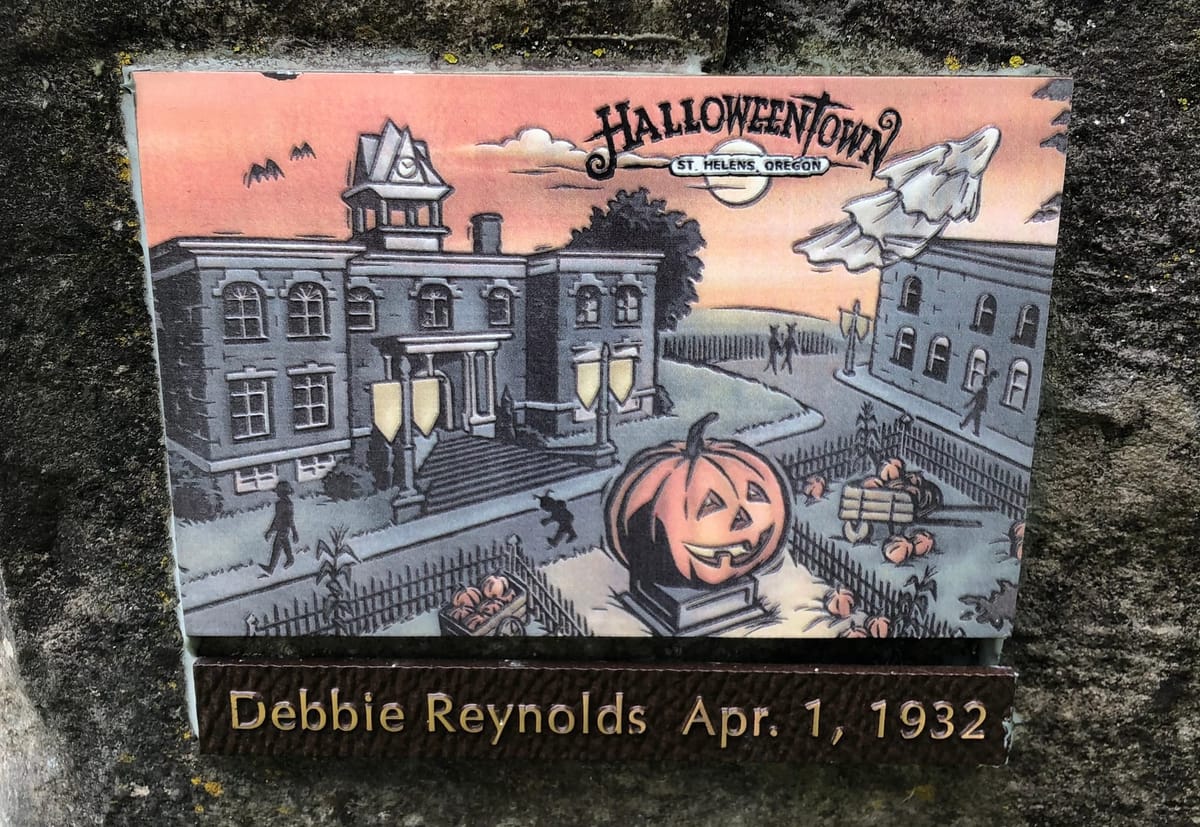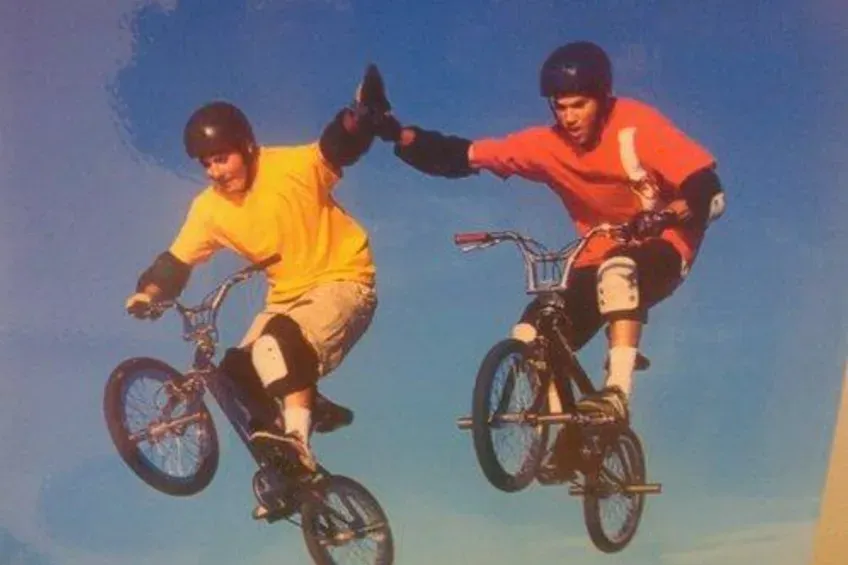The Spirit of Halloweentown Compels Us

For the past few years, I've "worked with" (read: "sat back and watched") two of my favorite directors, Brett Whitcomb and Bradford Thomason, as they made a documentary. In the planning stages, it was one thing and then it was another thing and then it was my ideal concept for a movie. This is impressive, as I had nothing to do with the concept. The directors called me and said one of the other concepts probably wouldn't work, and then asked if I had seen a Disney Channel film called Halloweentown, and I was like "Ch-yeah! Exsqueeze me, m'baking powder, but I've written about it."
This isn't my ideal concept because of any affection I have for Halloweentown, which is really fun, if a little boring at times. Halloweentown's got engaging performances and great costumes and I'm always happy to sit down with it, but I don't really care about how the movie was made. This documentary, The Spirit of Halloweentown, wasn't supposed to be, and did not become, about the Disney movie or its place in the wider world. It's about people who live in St. Helens, Oregon, where the first Halloweentown movie was filmed.
St. Helens has made the holiday a huge part of its identity and The Spirit of Halloweentown is about how some of the people who live there have reacted to that. Some of them love it and some haven't even seen Halloweentown, it's just the reason their neighborhood gets flooded with tourists every September and October. And that's where so many of my interests form up like Voltron to make my ideal concept: it's regular people's lives in the midst of spectacle and regular places becoming that spectacle, it's traditions that split communities, it's people adapting to weird circumstances, it's ambition in a small town, the surprising legacy of pop culture marginalia (especially Disney marginalia, which is especially fascinating to me), people attached to that marginalia, it's the headache and chaos of organizing anything with more than two people and all of this is centered around the most visually-distinct holiday. And that's before any of the themes that came up as filming started and the subjects' personal stories played out. Halloweentown is only sort of important to The Spirit of Halloweentown.
That said, let's talk about Halloweentown and how we got here.
Halloweentown was the fourth Disney Channel Original Movie (DCOM), after Under Wraps, You Lucky Dog and Brink. Those movies are about a mummy, Kirk Cameron eating raw animal meat and rollerblading, respectively. Under Wraps came out before my family had cable, but I still watched it a half-dozen times because DCOMs were mostly designed to be evergreen. They tied into holidays, or the beginning of the school year or sports seasons so that Disney had themed content already in the can, prepared for reruns.
They pumped these things out. In 1999, Disney released 8 DCOMs. In 2000, they released a new DCOM every month. There were DCOMs for Black History Month, St. Patrick's Day, Mother's Day. There are DCOMs like Zenon: Girl of the 21st Century that proved to be more popular than some of the stuff Disney was actually putting into theaters. DCOMs served as extended series finales (The Evens Stevens Movie) and launched Disney-backed musical acts (The Cheetah Girls).
More than anything, there were DCOMS that provided kid-appropriate spookiness. In the first ten years of DCOMs, Disney released twelve Halloween-themed movies. In that same span of time, there were only two Christmas-themed DCOMs.
Those ratios seem off until you realize Disney already had plenty of movies and cartoon shorts about Christmas. Before the DCOM project, Disney only really had three successful Halloween films– The Adventures of Ichabod and Mr. Toad, Hocus Pocus and The Nightmare Before Christmas-- and about 30 minutes of shorts to play on their 24-hour cable network every October. There were other things in the vault that would have worked, things like The Watcher in the Woods, Mr. Boogedy, Dr. Syn, Alias the Scarecrow, even something like The Black Cauldron, but Disney looked at those as failed experiments to appeal to an older demographic. The Black Cauldron, originally released in 1985, didn't even get a VHS release until 1998. Disney buried its spooky stuff.
I don't think it's that wild to assume Disney watched the early-to-mid 90s explosion of tween horror (things like Goosebumps, Are You Afraid of the Dark?, Eerie, Indiana, etc.), realized they were missing out on a huge market and used their DCOM series to bulk up an especially anemic area of its catalog. DCOMs were cheap, they were produced quickly and they were built to pop up in themed programming blocks once or twice a year.
Halloweentown is a little more special than most DCOMs. It's got Debbie Reynolds, the most famous actor to appear in a Disney Channel production, and it was directed by Duwayne Dunham, David Lynch's go-to editor, the man who cut Blue Velvet, Wild at Heart and every episode of Twin Peaks: The Return. It became seasonal viewing for so many families because it's well-made, but Halloweentown is still, in many ways, a utilitarian product that served a very specific purpose in Disney's marketing plans. The mandate was cable-exclusive content for an audience just old enough to be self-conscious about watching Disney cartoons. That they accidentally made something good was incidental to everything. Disney would have broadcast a nightmare collage of Caillou footage and AC/DC vocal tracks if they thought it would get decent ratings.
So what does that mean for St. Helens, Oregon, the town in this documentary? What does it mean that a town has remodeled itself in the image of a cable movie designed to fill a few hours of air time every October?
Practically, it means a movie that once served as an ad for The Disney Channel has been recontextualized as an ad for an entire town. All television programming is in some way an ad for the network it appears on, and the DCOMs were especially positioned as things you could only see if your parents paid for cable. Now that you can watch a rip of Halloweentown on YouTube, it's an ad for something that doesn't really exist. Maybe it's an ad for Disney+. Either way, that context doesn't really matter anymore. It's just a movie you can watch and enjoy. And that movie, which is specifically about a cool town, was filmed around a real place, rather than a soundstage, meaning that place, St. Helens, had a reason to throw a party.
St. Helens' annual celebration attracts joy and confusion and anger and long wait times at restaurants and enough interest in Halloween that some locals can work side jobs as ghost hunters. The celebration brings about 50,000 tourists to St. Helens every year, and this documentary is about some of the 14,000 people who were already around, living their lives.
If I can break down one of the themes of a movie I was involved with without getting too naval gaze-y (though, again, I'm admiring the directors' work and the subjects' lives, rather than anything I did): The Spirit of Halloweentown is, to me, about people dealing with rough things (starting a restaurant as an "outsider" in a small community, entering the adult world with a flaky dad who won't show up, losing loved ones, etc.) very indirectly, which they're able to do because this weird phenomenon sweeps through town for a few weeks a year and overflows the town with people celebrating. St. Helens is so small and the festivities around Halloweentown are so large that everything, no matter the sensitivity, is refracted through the prism of a big Halloween party. Nobody in this film experiences stress purely because of that party, but the way they deal with that party is always informed by their stress.
Sometimes, they're starting from similar issues and ending up in totally different places. The Spirit of Halloweentown checks in with a religious woman suffering from chronic pain, who has lost her husband, and a woman called the Queen of Halloweentown, who loses her mother and gets laid off. They're in separate scenes and, as far as I'm aware, don't know each other personally. These are two people coping with the deaths of people they deeply love, and both women are old enough that they were around before Halloweentown changed St. Helens. One of them hates the Halloween celebration because she thinks it glorifies Satan. The movie doesn't laugh at her for it, doesn't judge her beliefs, but she's clearly in a very negative, lonely place as she channels her grief into a crusade to get rid of everything Halloween-related. She lashes out at people. The Queen of Halloweentown channels her grief into an embrace of the celebration. She's making special gifts to pass out to kids with autism, who may be overwhelmed by all the stimulation, as she updates the directors on the turns her life has taken.
If you're a hammer, the cliche says, everything looks like a nail. If you live in Halloweentown, everything's a spooky clown lawn ornament. One of the subjects here would probably still devote herself to dance if she lived in Santa Fe, but she lives in St. Helens, so she's choreographing neck snaps into a zombie dance routine at the local high school. The new owner of the gorgeous historic restaurant and hotel has to walk a tightrope with the locals because he's gay and from the city, and winds up in the center of a PR crisis because Halloween is an absurdly busy time in his new town. Of course he's going to be damned by stress and Yelp entitlement. St. Helens' connection to Halloween makes it one of the few places, like New Orleans or Salem, where you could try to sustain a ghost hunting business. And that connection exists because a TV movie was shot there thirty years ago!
I've spent most of my life in the Bay Area and in Philadelphia. Grateful Dead and Rocky shirts have almost always had a place in my peripheral vision, and I know how a place will capitalize on the parts of itself a tourist would name first in a game of word association. The Spirit of Halloweentown is about St. Helens' "thing" and the intensity of people's devotion to it, but nobody in the film really cares about the original Halloweentown movie. They're just some of the most interesting people standing around when the Halloweentown tidal wave hits every year.
